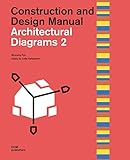Architectural diagrams. 2, Construction and design manual / Miyoung Pyo ; essay by Lidia Gasperoni ; translation Geoffrey Steinherz
Contributor(s): Pyo, Mi Young [editor] | Gasperoni, Lidia [contributor] | Steinherz, Geoffrey [translator].
Series: Construction and design manual: Publisher: Berlin : DOM Publishers, ©2019Copyright date: ©2019Edition: Extended edition.Description: 307 p: chiefly illustrations (chiefly color) ; 29 cm.Content type: text | still image Media type: unmediated Carrier type: volumeISBN: 9783869226736.Subject(s): Architecture, Modern -- Charts, diagrams, etc | Communication in architectural design | Architectural drawing | Architecture, Modern -- Designs and plansGenre/Form: Architectural drawings. | Charts, diagrams, etc. | Print books.Summary: "In the last few decades, the "diagram" has evolved into a constitutive, generative medium for the architectural design process and is now an everyday term used in the context of design. The diagram represents an imaginative process that enables architects to transform typologies, figures, and models using analogue and dig-ital design procedures. This process is creative and erratic - it is highly intuitive and variable and follows its own logic. As such, the diagram, with its lines, points, and strokes, operates at the intersection of geometry, art, and theory - (from the introduction). The second edition of this book from the series Construction and Design Manuals presents a selection of projects by prominent architects and designers in the form of diagrams, drawn from the fields of architecture, interior design, and installation. This volume also features an essay by the philosopher Lidia Gasperoni."| Current location | Call number | Status | Date due | Barcode | Item holds |
|---|---|---|---|---|---|
| On Shelf | NA2750 .P96 2019 (Browse shelf) | Available | AU00000000015554 |
Includes bibliographical references and index
"In the last few decades, the "diagram" has evolved into a constitutive, generative medium for the architectural design process and is now an everyday term used in the context of design. The diagram represents an imaginative process that enables architects to transform typologies, figures, and models using analogue and dig-ital design procedures. This process is creative and erratic - it is highly intuitive and variable and follows its own logic. As such, the diagram, with its lines, points, and strokes, operates at the intersection of geometry, art, and theory - (from the introduction). The second edition of this book from the series Construction and Design Manuals presents a selection of projects by prominent architects and designers in the form of diagrams, drawn from the fields of architecture, interior design, and installation. This volume also features an essay by the philosopher Lidia Gasperoni."


